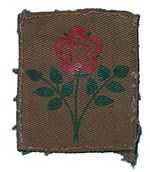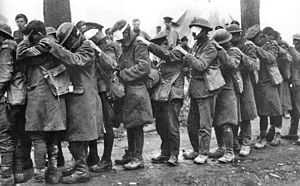55th (West Lancashire) Infantry Division
| 55th (West Lancashire) Infantry Division | |
|---|---|
 55th (West Lancashire) Infantry Division insignia (WW2) | |
| Active |
First World War November 1914 – January 1919 [reorganized] 1939–45 |
| Country | United Kingdom |
| Branch | Territorial Force |
| Type | Infantry |
| Engagements |
Battle of the Somme Third Battle of Ypres Battle of Cambrai Battle of Estaires |
| Commanders | |
| Notable commanders |
Sir William Morgan Sir Frederick Morgan |
The 55th (West Lancashire) Infantry Division was an infantry division of the British Army. It was raised in 1908 upon the creation of the Territorial Force originally as the West Lancashire Division, gaining its number in 1915. The division served with distinction on the Western Front during the Great War from 1915 to 1918. Disbanded after the war in 1919, it was reformed in the Territorial Army in 1920 and remained in the United Kingdom for the Second World War.
History
First World War
Originally, the division was raised in 1908 as the West Lancashire Division with the North Lancashire Brigade, the Liverpool Brigade and the South Lancashire Brigade under command. In 1915, during the First World War, it became the 55th (West Lancashire) Division and the 164th (North Lancashire) Brigade, the 165th (Liverpool) Brigade and the 166th (South Lancashire) Brigade respectively.
Between November 1914 and April 1915 the divisional brigades were detached as reinforcements with other divisions already in serving on the Western Front in France and Belgium. The 55th Division was reformed in January 1916. In April 1915 the 164th (North Lancashire) Brigade joined the 51st (Highland) Division as the 154th Brigade, but it returned to the 55th Division less than a year later, in January 1916.
The first Victoria Cross awarded by the reformed division occurred near Arras on the 17 April 1916 when 2nd Lieutenant Edward Felix Baxter won the award while on a raid by the 1/8th (Irish) Battalion, King's (Liverpool) Regiment. The division moved to the Somme on 25 July to take part in that battle. The division took part in the Battle of Guillemont and the Battle of Ginchy, followed by a short rest period before being thrown back into the Battle of Morval. The 55th Division was then moved to the Ypres salient, where it remained for up to a year.
In 1917 the division took part in the Third Battles of Ypres and Cambrai. At Cambrai they lost many men taken prisoner, apparently due to a collapse during a German attack.

After a rest and a period of retraining, the division took part in the Battle of Estaires in 1918, where it successfully fought the "First Defence of Givenchy" under the leadership of Major-General Hugh Jeudwine. This was to become the single most famous action that the Division fought. "It was afterwards publicly stated by an officer of the German General Staff that the stand made by the Division on April 9 and the days which followed marked the final ruination of the supreme German effort of 1918", says the Divisional history. Givenchy was eventually selected as the location of a fine memorial to the Division. By the Armistice on 11 November, the division had reached the Tournai area, having advanced fifty miles in eighty days.
Order of Battle World War I
From January 1916, the division comprised the following units:
- 164th (North Lancashire) Brigade
- 1/4th Battalion, King's Own (Royal Lancaster Regiment)
- 1/5th Battalion, King's Own (Royal Lancaster Regiment)
- 1/4th Battalion, Loyal North Lancashire Regiment
- 1/5th Battalion, Loyal North Lancashire Regiment
- 165th (Liverpool) Brigade
- 1/5th Battalion, King's (Liverpool Regiment)
- 1/6th Battalion, King's (Liverpool Regiment)
- 1/7th Battalion, King's (Liverpool Regiment)
- 1/8th Battalion, King's (Liverpool Regiment)
- 166th (South Lancashire) Brigade
- 9th Battalion, King's (Liverpool Regiment)
- 10th Battalion, King's (Liverpool Regiment)
- 1/4th Battalion, Prince of Wales's Volunteers (South Lancashire Regiment)
- 1/5th Battalion, Prince of Wales's Volunteers (South Lancashire Regiment)
- Pioneers
- 1/4th Battalion, Prince of Wales's Volunteers (South Lancashire Regiment)
- Royal Engineers
- 419th Field Company
- 422nd Field Company
- 423rd Field Company
- 55th Divisional Signal Company
Second World War
The division was disbanded after the Great War when the Territorial Force was disbanded but it was later reformed as the Territorial Army.
During the Second World War, the division was a 1st Line Territorial Army formation, but many of its units did not see active service overseas. One unit which did was the 510th Field Park Company of the Royal Engineers, which served in the North African theatre of the war.
At the start of World War II, the division was organised as a motorised infantry division with only two infantry brigades and was reorganised as a standard infantry division in June 1940 when the 66th (East Lancashire) Division was disbanded, after the BEF was evacuated from Dunkirk, and the 199th Brigade joined the 55th Division and it later became the 166th Infantry Brigade in August 1944. In October 1941, the division was no longer an operation formation to be sent overseas and, in January 1942, was placed on a Lower Establishment but did not become a training division as many others did. In December 1943 it was sent to Northern Ireland and came under command of British Troops Northern Ireland. In May 1944, shortly before the Allies invaded Normandy, the division was again raised to a Higher Establishment and returned to the mainland in July.
Order of Battle World War II
164th Infantry Brigade (disbanded July 1945)
- 9th Battalion, King's Regiment (Liverpool) (to 165 Brigade April 1943)
- 1/4th Battalion, South Lancashire Regiment (to 166 Brigade July 1944)
- 2/4th Battalion, South Lancashire Regiment (to May 1943, became 13th Parachute Battalion)
- 9th Battalion, South Lancashire Regiment (from 13 August 1943, disbanded July 1944)
- 9th Battalion, Buffs (Royal East Kent Regiment) (from 29 September 1943 to July 1944)
- 4th Battalion, Devonshire Regiment (from August 1944 until July 1945)
- 5th Battalion, Somerset Light Infantry (from August 1944 until July 1945)
- 1st Battalion, Duke of Cornwall's Light Infantry (from August 1944 until July 1945)
- 5th Battalion, King's Regiment (Liverpool) (to April 1943)
- 1st Battalion, Liverpool Scottish, (Queen's Own Cameron Highlanders) (to 166 Brigade July 1944)
- 2nd Battalion, Liverpool Scottish, (Queen's Own Cameron Highlanders) (to September 1942)
- 9th Battalion, King's Regiment (Liverpool) (from 12 April 1943, disbanded July 1944)
- 10th Battalion, Duke of Wellington's Regiment (from 13 September 1942, disbanded July 1944)
- 4th Battalion, Black Watch (from 26 July 1944)
- 2nd Battalion, Royal Irish Fusiliers (from 26 July 1944)
- 5th Battalion, West Yorkshire Regiment (from 28 August 1944)
166th Infantry Brigade (to 4 September 1939, redesignated 176th Infantry Brigade)
- 7th Battalion, South Staffordshire Regiment
- 6th Battalion, North Staffordshire Regiment
- 7th Battalion, North Staffordshire Regiment
177th Infantry Brigade (to 4 September 1939)
- 5th Battalion, South Staffordshire Regiment
- 1/6th Battalion, South Staffordshire Regiment
- 2/6th Battalion, South Staffordshire Regiment
199th Infantry Brigade (from July 1940, redesignated 166th Infantry Brigade August 1944)
- 2/8th Battalion, Lancashire Fusiliers (disbanded October 1944)
- 6th Battalion, Manchester Regiment (redesignated 1st Battalion, to September 1942)
- 7th Battalion, Manchester Regiment (to 1942)
- 2nd Battalion, Loyal Regiment (North Lancashire) (to October 1944)
- 9th Battalion, Bedfordshire and Hertfordshire Regiment (disbanded October 1944)
- 1/4th Battalion, South Lancashire Regiment (from 164 Brigade, July 1944)
- 1st Battalion, Liverpool Scottish (from 165 Brigade, July 1944)
- 8th Battalion, Manchester Regiment (from 28 November 1944)
Divisional Troops
- 5th Battalion, Loyal Regiment (North Lancashire) (Motorcycle battalion, converted to a Reconnaissance Corps unit, in 1941, for the 18th (East Anglian) Infantry Division and re-designated as the 18th Battalion, Reconnaissance Corps)[1])
- 6th Battalion, Loyal Regiment (North Lancashire) (formed as 2nd Line duplicate of 5th Battalion and converted and re-designated as 2nd Reconnaissance Regiment, for the 2nd Infantry Division, on 30 April 1941)
- 161st Regiment, Reconnaissance Corps (from 23 December 1943 to 24 July 1944)
- 1st Royal Gloucestershire Hussars (from 2 August 1944 until 15 June 1945, acted at the divisional reconnaissance regiment)
- 5th Battalion, Manchester Regiment (from 22 October 1944)
- 61st (North Midland) Field Regiment, Royal Artillery (to 4 September 1939)
- 66th Field Regiment, Royal Artillery (from 1 July 1940)
- 87th (1st West Lancashire) Field Regiment, Royal Artillery
- 109th (Westmorland and Cumberland Yeomanry) Field Regiment, Royal Artillery (from June 1940)
- 5th Field Regiment, Royal Artillery (from 1 August 1944, became 5th Light Regiment from 27 June 1945)
- 116th Field Regiment, Royal Artillery (to 4 September 1939)
- 136th Field Regiment, Royal Artillery
- 141st (Queen's Own Dorset Yeomanry) Field Regiment, Royal Artillery (from July 1944 until 11 June 1945)
- 66th (King's Own) Anti-Tank Regiment, Royal Artillery]]
- 89th (Liverpool Scottish) Anti-Tank Regiment, Royal Artillery (from 21 October 1944 until 29 August 1945)
- 150th (Loyals) Anti-Aircraft Regiment, Royal Artillery (from 1 August 1944)
- 509th Field Company, Royal Engineers
- 510th Field Company, Royal Engineers
- 205th (Wessex) Field Company, Royal Engineers (')
- 259th Field Company, Royal Engineers
- 283rd Field Company, Royal Engineers
- 511th Field Park Company, Royal Engineers (to 29 August 1944)
- 108th Field Park Company, Royal Engineers (from 30 August 1944)
- 9th Bridging Platoon, Royal Engineers (from )
- 55th (West Lancashire) Divisional Signals, Royal Corps of Signals
On 4 September 1939, a day after war was declared, the 55th (West Lancashire) Division was split up to form the 55th and 59th (Staffordshire) Division. The 59th Division received the 176th (ex 166th) and 177th brigades along with the 61st and 116th field regiments and the 6th Battalion, Loyal Regiment (North Lancashire). All other units remained with the 55th Division.
Battles
- Battle of the Somme (1916)
- Third Battle of Ypres
- Battle of Cambrai (1917)
- Battle of Estaires
Commanders
- Major-General Edward T. Dickson: April 1908-January 1909
- Major-General Edward C. Bethune: January 1909-June 1912
- Major-General Walter F.L. Lindsay: June 1912-August 1914
- Major-General Frederick Hammersley: August-September 1914
- Major-General John B. Forster: September 1914-1915
- Major-General Sir Hugh S. Jeudwine: January 1916-May 1919
- Major-General Sir Reginald W.R. Barnes: May 1919-April 1921
- Major-General Sir Cecil L. Nicholson: April 1921-April 1925
- Major-General Hugo D. De Pree: April 1925-July 1926
- Major-General Basil F. Burnett-Hitchcock: July 1926-September 1928
- Major-General Harold W. Higginson: September 1928-1930
- Major-General James Harrison1930–1932
- Major-General George Weir: September 1932-December 1933
- Major-General Sir James N. Cooke-Collis: January 1934-December 1935
- Major-General Ernest O. Lewin: December 1935-June 1938
- Major-General Vivian H.B. Majendie: June 1938-June 1941
- Major-General William D. Morgan: June-October 1941
- Major-General Frederick E. Morgan: October 1941-May 1942
- Major-General Hugh B. Hibbert: May 1942-August 1943
- Major-General Walter E. Clutterbuck: August 1943-July 1944
- Major-General Horatio P.M. Berney-Ficklin: July 1944-1945
See also
- List of British divisions in World War I
- List of British Divisions in World War II
- British Army Order of Battle - September 1939
References
Further reading
- Coop, J. A. (1919). The Story of the 55th (West Lancashire) Division (N & M Press 2009 ed.). Liverpool: Liverpool Daily Post. ISBN 1-84342-263-8. Retrieved 2 December 2014.